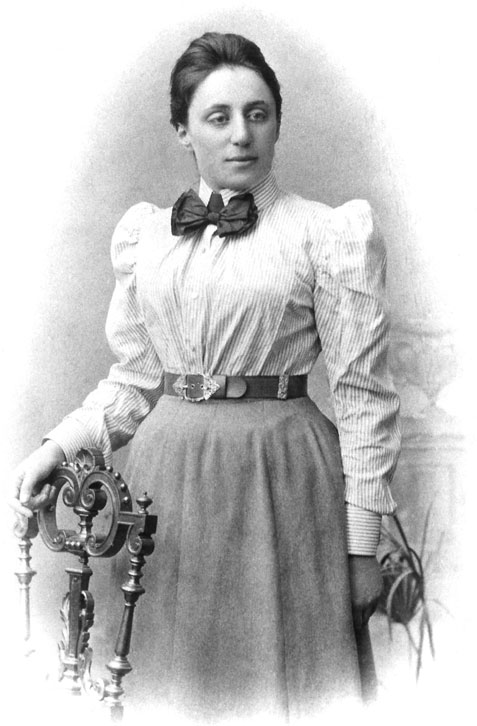
This Article From Issue
May-June 2025
Volume 113, Number 3
EINSTEIN’S TUTOR: The Story of Emmy Noether and the Invention of Modern Physics. Lee Phillips. 368 pp. PublicAffairs, 2024. $30.00.
From the very first page of Einstein’s Tutor: The Story of Emmy Noether and the Invention of Modern Physics, physicist and science writer Lee Phillips asserts that mathematician Emmy Noether belongs among the most familiar names involved in the invention of modern physics, next to Albert Einstein and Erwin Schrödinger, to name a few. He quickly makes it clear that she doesn’t belong there merely as Einstein’s tutor, as the title of the book suggests, but as an equal.

The early pages of the book are filled with a dizzying array of Noether’s accomplishments meant to unambiguously illustrate her exceptional mathematical talents and the singular significance of her contributions. Most strikingly, Noether’s 1918 theorem provides the foundation for a unified theory of physics by showing a clear relationship between symmetry and the conservation of energy. Her theorem “supplied the methodology for constructing the most accurate theory in the history of physics: the standard model. This framework encompasses all the elementary particles and their interactions—it is our modern theory of matter.” Her theorem also “provides the modern definition of the concept of energy and clarifies the importance of symmetry in nature.” Furthermore, Noether’s mathematics and “repeated and focused help” were essential for the completion of Einstein’s theory of general relativity. At a critical time when Einstein was struggling with the mathematics required for his theory, he relied on Noether’s work in abstract algebra and variational calculus to complete it. But despite her brilliant mathematics that continue to be applied across many areas of modern science—including physics, biology, and economics—Noether’s name is still unknown to many.
Noether was a Jewish German mathematician who relentlessly pursued a mathematics education and research career in the face of significant gender barriers and, especially during Hitler’s rise to power, religious discrimination. She earned her doctorate from the University of Erlangen and became a professor of mathematics at the University of Göttingen where she worked with some of the leading minds in mathematics at the time, including Felix Klein and David Hilbert.
A careful explanation of Noether’s 1918 theorem and how it redefined the role of symmetry in mathematics is the heart of the book. The theorem is actually four theorems: two theorems and their converses. They establish that conservation laws can be derived from symmetry and that symmetry can be derived from conservation laws, showing that these two essential ideas for understanding the structure of the universe, which had previously been treated as mathematically and conceptually separate, were in fact conceptually linked.
Phillips describes how before Noether, “symmetry was a guide to the overall patterns of reality. It served as a concise description and sometimes as an aid to constructing the solution to a problem.” After Noether’s theorem, symmetry had a new role: It could and did “govern what could and could not happen wherever it was present.” It was not just a pattern of reality anymore; it became a law.
Phillips spends a lot of time explaining Noether’s theorem in detail, and he succeeds in making it accessible to a general audience. Complex ideas from mathematics and science are presented using intuitive and conceptual examples, and he makes few assumptions about his reader’s prior mathematical knowledge. Some of the most elegant science communication in the book unfolds as Phillips walks us through what symmetry means in Noether’s theorem. He carefully explains that symmetry for Noether goes beyond familiar examples like mirror images or the symmetry between butterfly wings. Instead, a thing had symmetry for Noether “if it is the same in every way after you apply a transformation.” In other words, general symmetry describes any time you can make a transformation to something (such as by rotating or reflecting it) and change its meaning, but not its physical reality. Phillips helps his reader grasp this challenging idea with familiar examples. For instance, the ground floor of a building might be labeled the “1st floor” or the “lobby.” This example describes symmetry because the name of the floor has changed, but the physical reality of the building has not.
Though Phillips recognizes Noether’s remarkable skills and value as a mathematician, his clear assertions about Noether’s foundational role in modern science are often paired with far more hesitant explanations about how or why her male colleagues failed to credit her work at the time. He makes sure to note that Noether did not care for self-promotion, freely gave away results to students and younger colleagues, and was happy to provide help to those who needed it. When it comes to pointing out that her work was not consistently credited by her male colleagues, Phillips almost seems to apologize for breaking the news to the reader. Before detailing how physicist Wolfgang Pauli cited the work of all of his male colleagues in an encyclopedia article on relativity while excluding Noether’s essential contributions to the mathematics, Phillips writes that Pauli’s actions will be “painful for physicists to contemplate.” And there is a marked reluctance to his statement that “we must confront the apparent likelihood that certain authors suppressed or omitted her contributions where it would have been natural to do the opposite.”
Throughout Einstein’s Tutor, Noether emerges as a singular figure, capable of overcoming obstacles to contribute elegant and transformative solutions to thorny and significant problems in mathematics. Despite this insistence on Noether’s individual genius, the book puts forward a remarkable story about the importance of collaboration in the construction of mathematical and scientific theories. Describing mathematics at Göttingen in 1915, Phillips creates a picture of mathematicians and physicists like Klein, Hilbert, and even Einstein, all of whom we are accustomed to seeing as individual geniuses, embedded in an “academic web” of interdisciplinary work, dependent on one another’s ideas. And all of them are described as reliant on Emmy Noether’s fluency in complex mathematics to move forward in their work. In this way, Einstein’s Tutor asks us to reconsider who can be a genius, who is instead described as a collaborator, and how gender shapes the use of the trope of the scientific genius in the stories we tell about how modern science was made.
.
.png)




